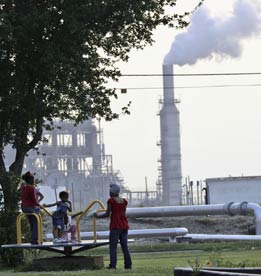
Children play on a merry-go-round near an oil refinery at the Carver Terrace public housing project in West Port Arthur, Texas. Photo AP/LMotero
The new president has a lot of catching up to do on the unmet imperatives of environmental justice. Originally anchored in the urgency of redressing the impact of environmental poisons and discriminatory pollution on workers and low-income people in communities of color, the environmental and economic justice movement forged a coherent vision that defines and addresses community health and vitality. This vision is about meeting community needs and aspirations, and positions those who live, work, worship, and are educated there as integral partners in decisions about policy and place.
Environmental and economic justice is the junction of human rights, civil rights, and the environment. It’s focused on creating a new sustainable-communities paradigm of quality of life, rooted in the democratic inclusion of affected people in decision-making and mobilizing resources to engage and protect them.
To ensure that environmental discrimination is addressed, Executive Order 12898 on Environmental Justice, issued by President Clinton in 1994, should be codified and Title VI of the 1964 Civil Rights Act should be reaffirmed. Codifying the order would establish an unequivocal mandate imposing federal responsibility for advancing equal protection under law. Reaffirming the right under Title VI to be free from discrimination would reverse the harmful 2002 U.S. Supreme Court decision in Alexander v Sandoval. Communities need this civil-rights remedy to redress discriminatory exposures and other impacts.
Your administration can set the bar higher for community development, so that the states and localities measure success in terms of air and water quality and human health and safety in addition to narrowly economic indicators of prosperity and equity. Contaminated and vacant properties proliferate in underserved urban and rural communities of color and low-income communities. They contribute to a cycle of blight and neighborhood distress — sprawl; disinvestment; concentrated poverty; infrastructure and transportation deficits; crime; limited or no access to capital, jobs, health care, or employment options; lack of affordable housing; inadequate schools; and multiple pollution hazards. Redevelopment is a means to build on assets while addressing these deficits.
America urgently needs a domestic Marshall Plan to revitalize declining urban and rural places. Generally, redevelopment funding should focus first on distressed places. Federal brownfields redevelopment should be fully funded. Predatory lending, the credit crisis, and foreclosures are important facets of effective plans. Tax credits and government subsidies should be linked to fairness and sustainability. Eligibility for redevelopment incentives is a public-policy quid pro quo. Beneficiaries should be required to conduct a Community Revitalization Analysis (CRA), commit to in-depth community planning, and take steps to address the most serious impacts identified in the analysis.
Reauthorize the federal Superfund law (CERCLA). Lack of program funds stymies local efforts to clean up dangerous, often abandoned hazardous waste sites in vulnerable communities and ready them for productive re-use. Science on the nexus between hazardous waste exposures and health effects is compelling. Restoring the cleanup tax and invigorating relocation policy will assist people at risk and those who want to move out of harm’s way.
Strengthen homeland security by protecting the nation’s communities imperiled by weaknesses in chemical and nuclear safety, emergency preparedness, and disaster response. Immediate deep investments are imperative — a national clean production initiative, quantum investments in infrastructure and the federal transportation program, strong energy conservation, and alternative energy policies.
Federal programs should promote clean fuels, toxics-use reduction, conservation, and biodiversity as well as parks, open space, and amenities that encourage wellness. Local food security should be a public-health priority. Making locally grown foods readily available in underserved communities where eating fresh is a challenge is not only healthy, it’s an energy-efficiency strategy, reducing the need for expensive chemical processing and high transportation costs.
There is a growing national grassroots movement built on the understanding that equity and sustainability go hand in hand. That means all Americans must have the right to broad participation in the emerging green economy, clean air and water, smart growth, mass transit, and safe, green housing.
Because sensitive populations are the bellwether for the harmful effects of environmental abuses, equity must underpin the policy discourse about how to reverse these practices. We’re all in the same boat. Communities of color and low-income people are closest to the hole. Plug the hole, save us all.





Comments